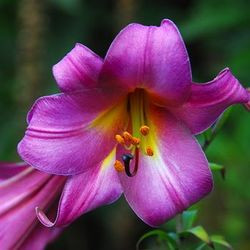Extremely showy and exotic-looking, lilies add drama to the landscape with their rich, bright colors, elegant and delicate shapes, and heavenly scent! There are hundreds of Lily Species and thousands of hybrids. With this choice, how does one pick?
Species Lilies are wild lilies, native to North America, Europe, and especially Asia. Delicate and full of charm, they make good garden plants, but might occasionally be challenging to grow.
The Hybrid Lilies, derived from these Species, are generally much easier to grow. The four best-known groups are Martagon Lilies, Asiatic lilies, Trumpet Lilies, and Oriental lilies.
- Among the earliest to bloom, these lilies are quite decorative with their pendant flowers sporting backward-curling petals, resembling Turk’s caps and presenting shades of pink, lavender, orange, red, yellow, and white often with speckles and freckles. Their leaves grow in whorls around the stem and are not alternatively scattered as with Asiatic or Oriental Lilies.
- While they may take a year to adjust to a new garden, they will thrive for years, once established.
- They enjoy full sun or part shade, slightly alkaline soils and don’t seem to be bothered by pests. They usually do not like hot, humid climates. Planted in spring, they are great companions for ferns and hostas.
- Highly popular, Asiatic hybrid Lilies are among the earliest to bloom in early-mid summer, and the easiest to grow. They offer a wide array of colors, from the softest pastels to fiery reds and oranges that practically ignite when the sun shines on them.
- They feature straight stems, high bud counts, and generally brightly spotted blossoms and vary in shape from simple open bowls to flowers with exquisitely recurved petals.
- Asiatic Lilies enjoy a long blooming season (up to 1 month) but most of them are unscented.
- Planted in spring or fall, they thrive in full sun to part shade locations and do great as potted plants or as cut flowers. They are not fussy about soils, provided they are fertile and well-drained. Good moisture is required and dry soils should be avoided.
- Blooming in mid-summer, Trumpet Lilies emit a heavy fragrance, and their huge waxy trumpet flowers, up to 6-10 in. long (15-25 cm), may be pendant, widely flaring in a shallow bowl shape or upward facing.
- Adding distinction and elegance to the garden, their colors vary from pure glistening white to bright gold, yellow, pink, plum, and apricot, with some having dramatic maroon petals on the outside of the trumpet.
- Tall and magnificent, they are easy to grow, produce up to 12-15 blooms per stalk for a spectacular long display and add color to the perennial border, at a time when it is lacking.
- Planted in spring or fall, they thrive in full sun to part shade locations and do great as potted plants or as cut flowers. They are not fussy about soils, provided they are well-drained. Good moisture is required and dry soils should be avoided. They are great companions to phlox, meadow rue, delphinium, and platycodon.
- Trumpet Lilies gradually blend into Aurelians as the season progresses. Aurelian hybrids are derived from a combination of Trumpet Lilies and Lilium henryi (Henry’s Lily), a tightly recurved lily, which accounts for the flaring of the petals, the wide bowls, sunbursts, and stars of these Aurelian Lilies. These late bloomers enjoy a long flowering season thanks to the occasional presence of secondary or tertiary buds.
- Known as the most flamboyant personalities in the world of lilies, they are characterized by their immense flowers, intense fragrance, and rich colors. Exotic-looking, these Oriental hybrids are derived from species native to Japan.
- Blooming over a long period of time, from mid to late summer and even into fall for some varieties, their flowers are usually large and open, outward facing or pendant with striking patterns of spots. Most Oriental Lilies are in shades of white, pink, and red, some with pretty yellow bands on their petals.
- Not as easy to grow as the Asiatic Lilies or Trumpet Lilies, they are still worth a try, just for the pleasure of possessing a magnificent plant in your own garden! Oriental Lilies prefer humus-rich soil that is acidic. Give them plenty of water and mulch for a cool root run.
While every effort has been made to describe these plants accurately, please keep in mind that height, bloom time, and color may differ in various climates. The description of these plants has been written based on numerous outside resources.

















